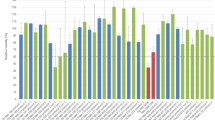Abstract
Purpose. The objective of this study was to evaluate the mucosal toxicity of different benzalkonium chloride (BAC) analogues using slugs as the alternative test organism.
Methods. The effect of different BAC analogues on the mucosal tissue of slugs was determined from the protein, lactate dehydrogenase, and alkaline phosphatase released from the foot mucosa after treatment. Additionally, mucus production and reduction in body weight of the slugs were measured. The eye irritation potency of the molecules was evaluated with the Bovine Corneal Opacity and Permeability (BCOP) assay. The antimicrobial activity of the different BAC analogues was also assessed.
Results. All BAC analogues induced severe damage to the mucosal epithelium of the slugs, and the irritation increased with decreasing alkyl chain length: BAC-C16 < BAC-C14 < BAC-C12 ∼ BAC-mix. A similar ranking was obtained with the BCOP assay for eye irritation. The relative order of activities among the three BAC analogues was the same, i.e., BAC-C14 ≥ BAC-C16 > BAC-C12. The BAC-C14 exhibited higher activity than the BAC-mix.
Conclusions. The toxicity and activity of BAC analogues depend on the alkyl chain length. The use of BAC-C14 as a conservative agent in pharmaceutical preparations instead of the BAC-mix should be considered.
Similar content being viewed by others
REFERENCES
J. Merianos. Quaternary ammonium antimicrobial compounds. In S. S. Block (eds.), Disinfection, Sterilization, and Preservation, Lea & Febiger, Philadelphia, 1991 pp. 225-255.
S. K. Steinsvag, R. Bjerknes, and O. H. Berg. Effects of topical nasal steroids on human respiratory mucosa and human granulocytes in vitro. Acta Oto-Laryngol. 116:868-875 (1996).
O. H. Berg, K. Lie, and S. K. Steinsvag. The effects of topical nasal steroids on rat respiratory mucosa in vivo, with special reference to benzalkonium chloride. Allergy 52:627-632 (1997).
P. Saarinen-Savolainen, T. Jarvinen, K. Araki-Sasaki, H. Watanabe, and A. Urtti. Evaluation of cytotoxicity of various ophthalmic drugs, eye drop excipients and cyclodextrins in an immortalized human corneal epithelial cell line. Pharm. Res. 15:1275-1280 (1998).
L. M. El-Hariri, C. Marriott, and G. P. Martin. The mitigating effects of phosphatidylcholines on bile salt-induced and lysophosphatidylcholine-induced membrane damage. J. Pharm. Pharmacol. 44:651-654 (1992).
M. P. Vinardell and M. R. Infante. The relationship between the chain length of non-ionic surfactants and their hemolytic action on human erythrocytes. Comp. Biochem. Physiol. C-Pharmacol. Toxicol. Endocrinol. 124:117-120 (1999).
M. Balls, A. M. Goldberg, J. H. Fentem, et al. The three Rs: The way forward—The report and recommendations of ECVAM workshop 11. ATLA 23:838-866 (1995).
E. Adriaens and J. P. Remon. Gastropods as an evaluation tool for screening the irritating potency of absorption enhancers and drugs. Pharm. Res. 16:1240-1244 (1999).
J. H. Draize, G. Woodward, and H. O. Calvery. Methods for the study of irritation and toxicity of substances applied to the skin and mucous membranes. J. Pharmacol. Exp. Ther. 82:377 (1944).
P. Gautheron, M. Dukic, D. Alix, and J. F. Sina. Bovine corneal opacity and permeability test—An in vitro assay of ocular irritancy. Fund. Appl. Toxicol. 18:442-449 (1992).
P. Vanparys, G. Deknudt, M. Sysmans, G. Teuns, W. Coussement, and H. Vancauteren. Evaluation of the bovine corneal opacity permeability assay as an in vitro alternative to the Draize eye irritation test. Toxicol. Vitro 7:471-476 (1993).
Deutsche Gesellschaft für Klinische Chemie. Standard method for determination of lactate dehydrogenase (LDH) activity. Z. Klin. Chem. Klin. Biochem. 10:287 (1972).
P. Gautheron, J. Giroux, M. Cottin, et al. Interlaboratory assessment of the bovine corneal opacity and permeability (BCOP) assay. Toxicol. Vitro 8:381-392 (1994).
A. South. Terrestrial Slugs: Biology, Ecology and Control, Chapman & Hall, London, 1992.
E. Marttin, J. C. Verhoef, S. G. Romeijn, P. Zwart, and F. Merkus. Acute histopathological effects of benzalkonium chloride and absorption enhancers on rat nasal epithelium in vivo. Int. J. Pharm. 141:151-160 (1996).
K. Morimoto, Y. Uehara, K. Iwanaga, M. Kakemi, Y. Ohashi, A. Tanaka, and Y. Nakai. Influence of absorption enhancers (bile salts) and the preservative (benzalkonium chloride) on mucociliary function and permeation barrier function in rabbit tracheas. Eur. J. Pharm. Sci. 6:225-230 (1998).
H. J. M. van de Donk, J. Zuidema, and F. W. H. M. Merkus. Correlation between the sensitivity of the ciliary beat frequency of human adenoid tissue and chicken embryo tracheas for some drugs. Rhinology 20:81-87 (1982).
T. Deitmer and R. Scheffler. The effect of different preparations of nasal decongestants on ciliary beat frequency in vitro. Rhinology 31:151-153 (1993).
O. H. Berg, K. Lie, and S. K. Steinsvag. The effect of decongestive nosedrops on human respiratory mucosa in vitro. Laryngoscope 104:1153-1158 (1994).
O. H. Berg, R. N. Henriksen, and S. K. Steinsvag. The effect of a benzalkonium chloride-containing nasal spray on human respiratory mucosa in vitro as a function of concentration and time of action. Pharmacol. Toxicol. 76:245-249 (1995).
W. M. Boek, S. G. Romeijn, K. Graamans, J. C. Verhoef, F. Merkus, and E. H. Huizing. Validation of animal experiments on ciliary function in vitro. II. The influence of absorption enhancers, preservatives and physiologic saline. Acta Oto-Laryngol. 119:98-101 (1999).
M. I. Imayasu, T. Moriyama, J. Ohashi, H. Ichijima, and H. D. Cavanagh. A quantitative method for LDH, MDH and albumin levels in tears with ocular surface toxicity scored by Draize criteria in rabbit eyes. CLAO 18:260-266 (1992).
Author information
Authors and Affiliations
Rights and permissions
About this article
Cite this article
Adriaens, E., Dierckens, K., Bauters, T.G.M. et al. The Mucosal Toxicity of Different Benzalkonium Chloride Analogues Evaluated with an Alternative Test Using Slugs. Pharm Res 18, 937–942 (2001). https://doi.org/10.1023/A:1010928025753
Issue Date:
DOI: https://doi.org/10.1023/A:1010928025753




